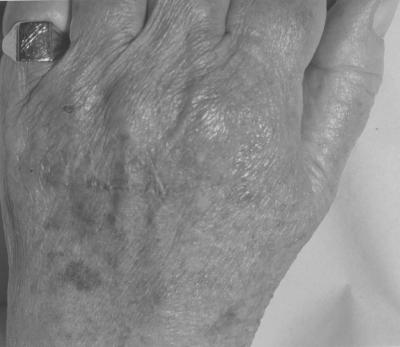In a patient with a joint prosthesis, animal-related injuries present special hazards. Antimicrobial prophylaxis may be needed after a bite or scratch—but with what?
CASE HISTORY
A woman of 73 was admitted after two days of pyrexia and general malaise, some fourteen months after a routine knee arthroplasty. She also reported a flu-like illness and rigors 12 days previously. She was generally unwell, with a temperature of 37.7°C and a painful, red, hot and swollen knee. She had a peripheral blood neutrophilia, and her C-reactive protein was raised at >110 mg/L. With a provisional diagnosis of septic arthritis the knee joint was aspirated, and microscopy of the fluid revealed >105 polymorphs per mL but no organisms. Treated empirically with intravenous flucloxacillin, she underwent arthroscopic washout of the knee with 10 L warmed saline. The next day, despite clinical improvement, the knee remained swollen and painful. Blood cultures were sterile, but after 24 hours Pasteurella multocida was isolated from the joint fluid. She then remembered being scratched by her pet cat on the dorsum of the hand two weeks previously (Figure 1). The antibiotic therapy was changed to intravenous benzyl penicillin 1.8 g four times daily and oral ciprofloxacin 750 mg twice daily, the latter orally because of its excellent absorption by that route. A thorough open debridement was planned, but the large amount of pus and slimy material and the severe synovitis at surgery dictated a first-stage revision. The implant and cement were completely removed, aggressive debridement was performed, and gentamicin-loaded beads and a gentamicin spacer were left in situ. Intravenous antibiotics were continued until her inflammatory markers returned to normal, and she was discharged home to take oral amoxicillin and ciprofloxacin for a further six weeks.
Figure 1.
An old cat scratch on the patient's hand
Ten weeks later she underwent an uneventful second-stage procedure, and at one year follow-up she was well and pain-free, with range of knee movements 5–110°.
COMMENT
All but one1 of the eighteen reported cases of P. multocida prosthetic joint infection have been in women.2–5 Our case is the fourth to follow a cat scratch. P. multocida is an oral commensal of dogs and cats, transferred via saliva to the claws when they lick their paws. Whether the injury is a bite or a scratch, the offending animal is more likely to be a cat than a dog: of the eighteen joint infections only three followed dog-related trauma. In the present case we believe that inoculation of pasteurella during the scratch injury led to the flu-like illness—a primary bacteraemia that resulted in haematogenous seeding of pasteurella into the joint.
Patients with pasteurella prosthetic joint infection may present as little as 24 hours after injury and as long as three months, particularly if symptoms are masked by steroid treatment.2–5 Early suspicion of pasteurella infection is the key to successful joint salvage. A typical case would be a woman with rheumatoid arthritis who gives a history of cat-related trauma. If no organisms are seen on Gram staining of the joint fluid, addition of cefotaxime or ciprofloxacin to the antimicrobial regimen pending culture is prudent. Pasteurella spp. are intrinsically resistant to flucloxacillin, and less than 20% are sensitive to erythromycin. Numerous breakthrough infections have been reported in patients taking erythromycin, including one patient with bilateral prosthetic knee infections after a cat bite who developed pasteurella septicaemia on treatment.4
Our recommended initial approach to pasteurella prosthetic joint infections, aimed at salvaging the prosthesis, is aggressive surgical debridement together with intravenous ciprofloxacin 400 mg twice daily and benzyl penicillin 2.4 g four times daily. Removal of the prosthesis became necessary in one-third of the reported cases.
What of prophylaxis after animal-related injuries? The main risk is posed by cats, and we agree with others2–5 that all cat bite victims with prosthetic joints should receive antimicrobial prophylaxis. We also favour prophylaxis in such patients with prosthetic joints who have sustained a deep cat scratch. The most suitable antimicrobial is co-amoxiclav, 625 mg by mouth three times daily for three days. This agent acts not only against pasteurella species but also against most other members of the oral flora of animals.6 For the genuinely penicillin allergic individual, possible alternatives are tetracycline, ciprofloxacin or linezolid.
References
- 1.Chikwe J, Bowditch M, Villar RN, Bedford AF. Sleeping with the enemy: Pasteurella multocida infection of a hip replacement. J R Soc Med 2000;93: 478-9 [DOI] [PMC free article] [PubMed] [Google Scholar]
- 2.Takwale VJ, Wright ED, Bates J, Edge AJ. Pasteurella multocida infection of a total hip arthroplasty following cat scratch. J Infect 1997;34: 263-4 [DOI] [PubMed] [Google Scholar]
- 3.Maradona JA, Carton JA, Rodriguez Guarardado A, Lizon Castellano J. Prosthetic joint infection by Pasteurella. J Eur J Clin Microbiol Infect Dis 1997;16: 623-5 [DOI] [PubMed] [Google Scholar]
- 4.Orton DW, Fulcher WH. Pasteurella multocida: bilateral septic knee joint prostheses from a distant cat bite. Ann Emerg Med 1984;13: 1065-7 [DOI] [PubMed] [Google Scholar]
- 5.Spagnuolo PJ. Case report: Pasteurella multocida infectious arthritis. Am J Med Sci 1978;275: 369-3 [DOI] [PubMed] [Google Scholar]
- 6.Goldstein EJ, Citron DM. Comparative susceptibilities of 173 aerobic and anaerobic bite wound isolates to sparfloxacin, temafloxacin, clarithromycin, and older agents. Antimicrob Agents Chemother 1999;43: 1475-9 [DOI] [PMC free article] [PubMed] [Google Scholar]



